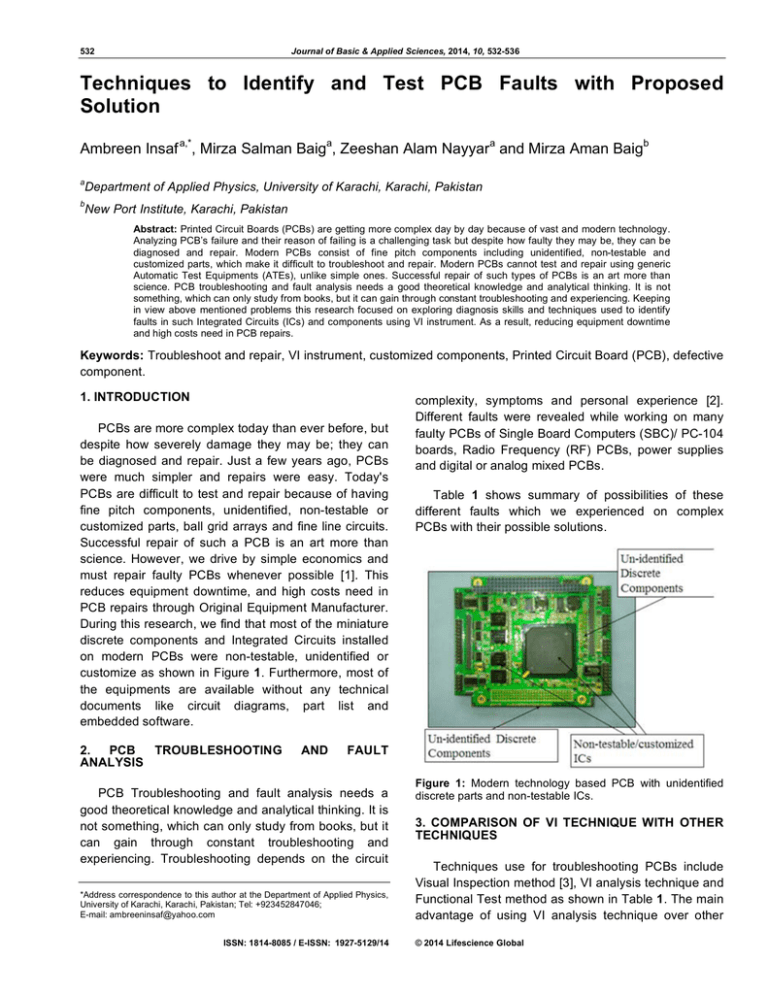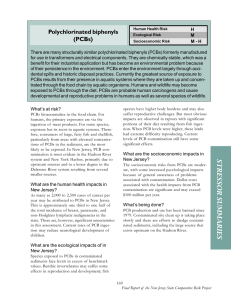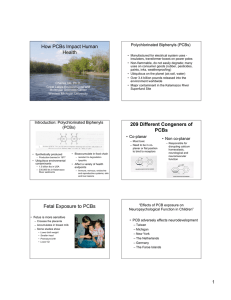this PDF file
advertisement

532 Journal of Basic & Applied Sciences, 2014, 10, 532-536 Techniques to Identify and Test PCB Faults with Proposed Solution Ambreen Insaf a,*, Mirza Salman Baiga, Zeeshan Alam Nayyara and Mirza Aman Baigb a Department of Applied Physics, University of Karachi, Karachi, Pakistan b New Port Institute, Karachi, Pakistan Abstract: Printed Circuit Boards (PCBs) are getting more complex day by day because of vast and modern technology. Analyzing PCB’s failure and their reason of failing is a challenging task but despite how faulty they may be, they can be diagnosed and repair. Modern PCBs consist of fine pitch components including unidentified, non-testable and customized parts, which make it difficult to troubleshoot and repair. Modern PCBs cannot test and repair using generic Automatic Test Equipments (ATEs), unlike simple ones. Successful repair of such types of PCBs is an art more than science. PCB troubleshooting and fault analysis needs a good theoretical knowledge and analytical thinking. It is not something, which can only study from books, but it can gain through constant troubleshooting and experiencing. Keeping in view above mentioned problems this research focused on exploring diagnosis skills and techniques used to identify faults in such Integrated Circuits (ICs) and components using VI instrument. As a result, reducing equipment downtime and high costs need in PCB repairs. Keywords: Troubleshoot and repair, VI instrument, customized components, Printed Circuit Board (PCB), defective component. 1. INTRODUCTION PCBs are more complex today than ever before, but despite how severely damage they may be; they can be diagnosed and repair. Just a few years ago, PCBs were much simpler and repairs were easy. Today's PCBs are difficult to test and repair because of having fine pitch components, unidentified, non-testable or customized parts, ball grid arrays and fine line circuits. Successful repair of such a PCB is an art more than science. However, we drive by simple economics and must repair faulty PCBs whenever possible [1]. This reduces equipment downtime, and high costs need in PCB repairs through Original Equipment Manufacturer. During this research, we find that most of the miniature discrete components and Integrated Circuits installed on modern PCBs were non-testable, unidentified or customize as shown in Figure 1. Furthermore, most of the equipments are available without any technical documents like circuit diagrams, part list and embedded software. 2. PCB TROUBLESHOOTING ANALYSIS AND complexity, symptoms and personal experience [2]. Different faults were revealed while working on many faulty PCBs of Single Board Computers (SBC)/ PC-104 boards, Radio Frequency (RF) PCBs, power supplies and digital or analog mixed PCBs. Table 1 shows summary of possibilities of these different faults which we experienced on complex PCBs with their possible solutions. FAULT PCB Troubleshooting and fault analysis needs a good theoretical knowledge and analytical thinking. It is not something, which can only study from books, but it can gain through constant troubleshooting and experiencing. Troubleshooting depends on the circuit *Address correspondence to this author at the Department of Applied Physics, University of Karachi, Karachi, Pakistan; Tel: +923452847046; E-mail: ambreeninsaf@yahoo.com ISSN: 1814-8085 / E-ISSN: 1927-5129/14 Figure 1: Modern technology based PCB with unidentified discrete parts and non-testable ICs. 3. COMPARISON OF VI TECHNIQUE WITH OTHER TECHNIQUES Techniques use for troubleshooting PCBs include Visual Inspection method [3], VI analysis technique and Functional Test method as shown in Table 1. The main advantage of using VI analysis technique over other © 2014 Lifescience Global Techniques to Identify and Test PCB Faults with Proposed Solution Journal of Basic & Applied Sciences, 2014 Volume 10 533 Table 1: Possible Faults and their Proposed Solutions for Complex PCBs Possible faults Probability of fault Proposed Solutions Visual inspection VI Functional test Chance of fault Recovery Solder joints 25% HIGH Track Problems 05% MEDIUM Discrete Component 30% HIGH Basic Digital ICs 20% HIGH High pin Count ICs/Customized component 5% Software 15% methods is that it is only stand-alone equipment which can test all the possible faults including customized ICs. However it cannot test software corruption problems. Therefore, it is better to use single economical and simple technique or instrument for different fault problems instead of using multiple instruments or methods for diagnosing different faults. Moreover, using VI analysis technique defective PCBs can be diagnosed and repaired quickly as compare to other techniques. This power-off technique can be applied to any board and is therefore ideal when little or no information is available about the device or networks being tested. 4. STRATEGY FOR PCB TROUBLESHOOTING LOW MEDIUM equipment. Instrument use to observe VIcharacteristics of component, whether alone or connected in a circuit, is analyzed by applying the VAC stimulus signal of different frequencies across the component (mostly with respect to ground). 4.2. Fault Location and Rectification Unlike functional test of Integrated Circuits, VI instrument only tests input and output stages. It provides a rapid indication of possible damage, for example, static damage destroying the protection diodes or damage to output or input transistors of IC. However, it is up to person’s skills and understanding that how they identify defective or degraded components and other defects (like dry sold and broken tracks) by analyzing the VI signatures. It comprised of three distinct phases VI signature analysis can be done in two ways: (1) (2) (3) Fault Detection: It is a process of finding possible faults. For fault detection, we have used VIinstrument. Fault Location: It is a process to narrow down the search for fault and pinpoint the fault by finding its location. This process depends on person’s skills that how they reveal fault location. This article mainly focuses techniques for removing faults after detecting faults through VI instrument. Rectification: It is a process of replacing a faulty component with good one. 4.1. Fault Detection The VI-signature analysis is a fault detection. Specially in a comprises of the unidentified or which cannot test functionally useful technique for case where PCB high pin count ICs, through any other 1. By using the probe (preferable for discrete components). 2. By using different package styles test clips for ICs. This qualitative test will reveal defective, counterfeit and unidentified parts as well as short–circuits, opencircuits, bad connections and leakage faults [4]. 5. VI SIGNATURE ANALYSIS FOR TESTING PCBS FAULTS Components mounted on a PCB are connected in different combinations such as series, parallel or mix parallel or series combinations. It is difficult to identify the signatures of these combinations. Therefore, in such cases the best solution is to compare the signature of defective PCB with known good PCB (if available). Else compare one or more similar defective PCBs. 534 Journal of Basic & Applied Sciences, 2014 Volume 10 5.1. Comparison with known Good PCB Let us explain the procedures how to reveal the fault from the defective PCBs, if known good PCB is available. Figure 2 shows the VI instrument which represents the comparison of defective PCB with known good PCB. There are two probes; A (red) and B (green) use to compare the two PCBs and the common test lead grounds the PCBs with the instrument. Figure 2: VI instrument. Touch the pins of the similar ICs or other components on the both PCBs with the test probes and observe the signature. If the signatures of the pins are identical like shown in Figure 3, then there is no fault at that point. However, if the signatures of the same pins are different like shown in Figure 4, then consider it as an indication of fault. As mentioned earlier, it is up to person’s own skills and understanding that how they reveal defects by analyzing the VI signatures. Because many times signatures are slightly different, so it is up Figure 3: Identical signatures at same pins of two similar PCBs. Insaf et al. to person’s decision either consider it as component tolerance or indication of fault. Here we proposed some experienced based techniques and procedures to narrow down or pin point the fault: 1. First, remove the possibility of dry sold or bad connection by refreshing the point of IC or component using soldering station, where signatures are different. After refreshing check the signatures again. Most of the times it works because complex PCBs have a complexity index more than 75% [5]. Therefore the chance of dry sold and bad solder joints is high. However, if refreshing the solder joints does not work, then go to next step. 2. Now with the help of the multi-meter and circuit diagram (if available) or known good PCB, verify the tracks which were connected to that point. Often, tracks are broken, which are repaired through jumper wire. Check the signature again. If no broken track is found, then move to the next step. 3. Functionally test all the ICs or components connected to that point by using in-circuit test clip or multi-meter (if possible). Else carefully remove the ICs or other components. Check it functionally by out-of-the circuit test, if anyone found defective, replace it with good one [4]. 5.2. Comparison with Defective PCB Now let us explain, how to reveal the defects from the faulty PCB if known good PCB is not available but one or more similar defective PCBs are available for comparison. Techniques to Identify and Test PCB Faults with Proposed Solution Journal of Basic & Applied Sciences, 2014 Volume 10 535 Figure 4: Different signatures at same pins of two similar PCBs. For such a case where two similar PCBs are defective, follow the same procedure as mentioned above for comparison with known good PCB. If signatures on both defective PCBs are same, those components or pins of ICs are consider good one (chance for two PCBs to have same faults is very less). Only those points are attention dragging where signatures are not same and for this case, both PCBs are examine separately and take the following steps: 1. First, refresh faulty points on both PCBs using soldering station to remove the possibility of dry sold and check the signature again. If signatures are now same for both PCBs, fault is removed else fault remains there and move to next step. 2. Now with the help of the multi-meter and circuit diagram (if available) verify the tracks of both PCBs, which connect to that pin. Possibly tracks of any PCB may be broken, which repairs through jumper wire. Check the signatures again, if signatures are same consider that fault is removed but if no broken track is found, then move to the next step. 3. Functionally test all ICs or components connected to that point using in-circuit test clip or multi-meter (if possible). Else carefully remove the IC or other components of both PCBs. Check it functionally by out-of-circuit test (if possible). If any component is faulty replace it with new good component. 4. If functional test of IC or other components (like microprocessors, Rams or other high pin count ICs) is not possible then compare the VI signatures of ICs or other components by out-of- circuit test. If difference exists at any pin of the component or IC, it means that any one or both suspected components are faulty. Compare both components one by one with the new good component, else cannibalize both components with each other. Now check both PCBs on the system, if PCB works properly it means the cannibalized component of defective PCB must be replaced. 6. CONCLUSION We conclude that our proposed techniques using VI instrument is an effective tool for identifying and testing different electronic components mounted on modern PCBs without powering it up. This technique plays an important role in analyzing the behaviour of nontestable components such as a microprocessor; high pin count ICs; RAMs, etc., as shown in Figure 1. Also conclude that this technique is the only economical solution for high pin count or customize ICs and military specification parts. Because we did not find any standalone equipment, which can functionally test such devices. Comparing VI signatures of defective PCB with the known good PCB (if available) or with one or more defective PCBs as shown in Figure 2 and following the proposed procedures, one can easily reveal the defective circuits. As a consequence, defective PCBs are diagnosed and repair quickly, it reduces equipment downtime and high costs acquire in PCB repairs through OEM. It is recommended that in all cases, one must save the VI signature’s data like shown in Figures 3 and 4, as a reference so in future there is no more need of known good PCB. 536 Journal of Basic & Applied Sciences, 2014 Volume 10 Insaf et al. ACKNOWLEDGEMENT [3] Authors acknowledge the small financial support provided by University of Karachi. Wu H, Xianmin Z, Yongcong K, Gaofei O, Hongwei X. Solder joint inspection based on neural network combined with genetic algorithm. Optik - Int J Light Elect Opt 2013; 124(20): 4110-4116. [4] Baig MS, Insaf A. Troubleshooting Techniques of Complex Multi-Layered PCBs. J Basic Appl Sci 2012; 8: 456-462. REFERENCES [5] Stig O. A New Test Strategy for Complex Printed Circuited Board Assemblies.Proceedings of NepCon west. Reed Exhibition 1999; 1087-1099. [1] Ferry J. PC Board Rework and Repair. Circuit Technology Centre, INC 1998. [2] Hassan AP. Troubleshoot electronic components techniques. 2008. http://www.articleslash.com/author/Ahmad_Perdous_ Hasan Received on 27-11-2014 Accepted on 09-12-2014 Published on 18-12-2014 http://dx.doi.org/10.6000/1927-5129.2014.10.71 © 2014 Insaf et al.; Licensee Lifescience Global. This is an open access article licensed under the terms of the Creative Commons Attribution Non-Commercial License (http://creativecommons.org/licenses/by-nc/3.0/) which permits unrestricted, non-commercial use, distribution and reproduction in any medium, provided the work is properly cited.

